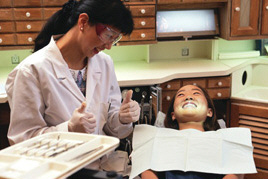

Diagnosis:
The first step in treating your child is to fully understand the nature of the problem. In order to arrive at a proper diagnosis the dentist will take a series of records. These may include study casts of your child's teeth, photographs of the face, x-rays of the teeth and jaws, and a single x-ray of the skull called a cephalometric radiograph.
Once the doctor has all of this information, he or she can diagnose the exact cause of your child's problem. It is important that you, the parent, understand that the alignment of dental units is usually more complex than just crooked teeth. The dentist must not only straighten the teeth, but must establish the balance and harmony within the jaws, face and the tempro-mandibular joint.
Treatment:
The exact type of treatment that will be required to correct your child's problem will obviously depend upon the information that was gained from the diagnosis. However, we can divide therapy into four general categories. They are functional orthopaedic therapy, extraction therapy, surgical therapy and fixed appliance therapy. In order to eliminate confusion, let's briefly define those four concepts of treatment.
When a removable orthopaedic appliance is used to correct jaws that are growing improperly. A different form of appliance may be required to treat different growth problems.
When the removal of permanent teeth is required in order to correct an orthodontic problem. This technique is used very selectively as it is usually in the patient's best interest to maintain all of the permanent teeth if possible.
Just as the name implies, this procedure is reserved for those patients whose bony imbalance has progressed to the point that only surgical intervention can correct the problem.
This is the conventional appliance technique using fixed braces. The appliance is attached to each individual tooth for precise positioning of the teeth.
It should be noted that quite frequently two or more of these techniques are combined in order to achieve the desired results. Your dentist will explain to you the type of treatment that can best correct the patient's problem.